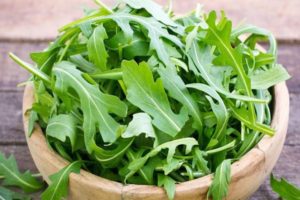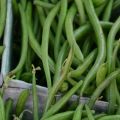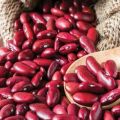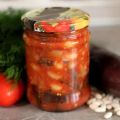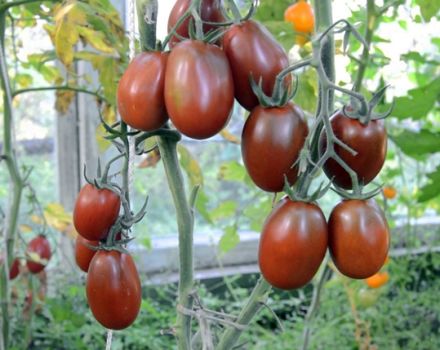Planting, growing and caring for beans outdoors, when to harvest and how to save for the winter
The cultivation of each crop has its own characteristics, it requires strict adherence to the rules in care. Only then can you get a good harvest and provide yourself with food for a certain period. Next, let's look at growing and caring for beans outdoors.
Description of the plant
There are many varieties of this plant, which is a storehouse of fiber and plant proteins for humans. Legumes have been known for a long time. They were grown by our ancestors in large quantities, as they were the main source of food. Being very nutritious and healthy, they deservedly occupied most of the area in the gardens of people in the countryside.
In addition to the large amount of beneficial trace elements, the legume plant provides another benefit. After the autumn digging of the soil, together with its stem and root parts, the earth is perfectly fertilized.
Legumes are annual plants. They have an erect stem, can grow from 40 to 120 cm.
Leaves are unpaired or paired, depending on the variety. As the beans grow, they develop a powerful rhizome. During flowering, whole inflorescences are formed. The fruits appear as pods. They can be of various lengths and widths. It depends on the variety and the adequacy of the nutrient supply during growth. Inside the pod are seeds and gradually ripen. Their color range, total yield, ripening period of fruits, resistance to cold and temperature changes vary depending on the crop.

Types and varieties of beans
The legumes popular today are valued for their exceptional taste, along with nutritional value and benefits for the human body.
There is a conditional modern gradation of legumes into main groups:
- Northern varieties. Such species give high yields in regions with moderate and colder climates.
- Western European. They occupy fields in hot, southern regions, where arid conditions are frequent companions in growing crops.
Depending on the region, the degree of ripening and other parameters, you can choose the variety that is most suitable for growing in a particular area. At the moment, some preferences have formed among legume consumers. Which, of course, affects the development of agriculture in this direction.

Belarusian
The name comes from the country of origin of the culture. The variety appeared in 1950. Mid-season peeling species. It takes about 100 days from the moment of sowing to the appearance of fruits. Flowering occurs 25 days after germination. The stem reaches a height of 50 to 100 cm. The length of the pod is about 10 cm. The seeds are elongated and have a pale brown color. Perfect for canning.
Windsor
There are white and green subspecies. Bred over two centuries ago by breeders from England. Medium ripeness. From sowing to fruit ripening, it takes about 120 days. The white variety ripens 10 days longer. The stem of these crops often exceeds a meter in height. The pods are small. Their shape is slightly curved and swollen. Inside there are usually 2 large flat green fruits. It is rare to find 3 or 4 pieces.
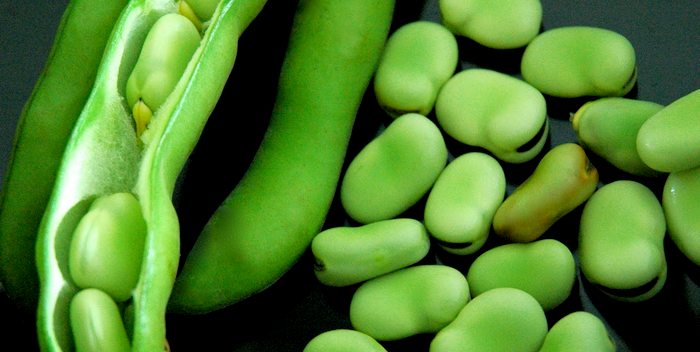
Russian black
The name was given to legumes in 1943 for the color of the seeds - dark purple. Fruits are oval, slightly oblong, wrinkled, of medium early ripeness. Ripen 90 days after sowing. The pod is about 8 cm long, slightly curved. Due to the absence of the pigment layer, it can be eaten whole.
Due to its cold resistance, the variety is planted in the northern regions. The height of the bush sometimes reaches 110 cm, but there are also lower - from 60 cm;
Virovsky
Medium early grade. The stem is erect, reaching a height of 1 meter. There can be 3-4 fruits in a pod. Large matte, milky or lemon yellow in color. The bob itself is slightly curved. Its length is 9 cm. Seeds ripen 100 days after sowing. The stem part of the culture can be 80-90 cm high. Resistant to many diseases.

Features of growing beans
The beans are hygrophilous. They give high yields with good watering during the flowering of the crop. They can grow even on heavy soils with a dense structure.
The main requirement for it is sufficient fertilization. Soil rich in organic matter will help you get a high yield.
Before growing, you should prepare the seeds themselves. This implies some growth stimulation and decontamination. That after planting in open ground will lead to the early germination of the bean and relieve the attacks of the pest during the development of the stem part of the plant.
Outdoor planting
Legumes can be planted outdoors in early spring due to their cold tolerance. But it is still better to wait for the ground to warm up a little, while remaining sufficiently moist. Sowing dates will vary in different regions. Here you have to choose the optimal conditions and time yourself.

In order to get an increased yield in the future, you should carefully consider the observance of some rules for growing legumes:
- Choosing a place for sowing. A site where cabbage, potatoes or cucumbers were previously grown is suitable. It is not worth planting legumes in one place for two years in a row. It is necessary to ensure crop rotation.
- Autumn composting into the soil. Humus or mullein will do. For 1 sq. m to scatter 3 kg of substance. Fertilizers with a high nitrogen content are not suitable for legumes. Therefore, you must be careful when using chicken manure. The introduction of superphosphates will be very useful.
- Seed preparation. Not a complicated procedure. Can be easily dealt with at home. First you need to select mature ones. By eliminating seeds with pests. These can be identified by the presence of a hole on the surface of the bean. An insect or its larva often hides there. Further, it will be enough to soak selected seeds in warm water for at least 10-15 hours. The optimum temperature will be +50. You can leave them there for a day. This will help the thick coat of the bean to open faster after sowing. It will also be useful to carry out disinfection.For these purposes, specialized stores sell various formulations with which instructions are attached.
Preparing the soil for planting
Spring soil preparation involves loosening the top layer and spreading the rows. The row spacing should be 45-50 cm. This will facilitate further care of the crop and will enable the rhizome to develop normally. In a well-moistened soil, spread the seeds at a distance of about 15 cm.Calculate the depth within 5-7 cm.
For legumes, you can use a combined planting with other vegetables. Then the seeds are planted between rows. This approach will ensure the disposal of garden crops from aphids. For some time after sowing, it is necessary to regularly moisten the soil until the shoots appear.

Seed planting dates
Legumes are not very heat demanding, but they do like good light. Seedlings will appear in cool climatic conditions. Therefore, the beans can be sown outdoors in early spring. They are not afraid of even small frosts. Resistant to -4 ° C. Comfortable conditions for the development and formation of fruits + 22 ° C. High temperature is detrimental to the culture - leaves fall off, fruits do not ripen.
Bean Care Tips
The legume patch should be weeded periodically. Although their root system does not allow the appearance of a large number of weeds around the bush, it will still be useful to loosen the soil around the crop. When the plant reaches about 50 cm, you can huddle it. That will ensure sustainability of the culture.
The second such hilling should be done before the formation of fruits. In this case, you contribute to the protection of the culture from possible diseases.
How and with what to fertilize?
After weeding, complex liquid organic mineral compositions are introduced into the aisles. Fertilize the culture per 1 sq. m of soil, a maximum of 10 g of superphosphate, 5 g of potassium salt and the same amount of ammonium nitrate.
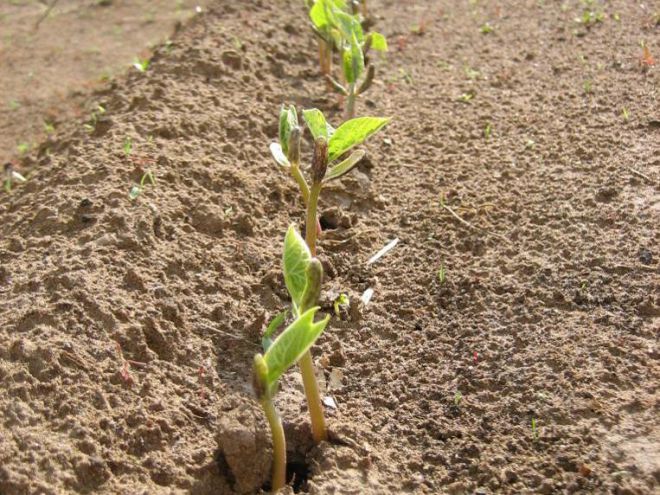
How to tie?
Cultivars that are tall should be tied up for more stability to keep the pods from sticking to the soil. Their close contact with the ground can lead to rotting of the fruit. Effective tying involves attaching the raised stem to stakes inserted into the soil next to the bush. They will become a pillar of culture.
You can additionally pull a strong cord or wire through the entire row of pegs for greater structural stability.
It is important to pinch the tops of the plant during the flowering period. This will effectively protect the shoots from aphids. The insect feeds on the juice of young legume shoots. The tops are cut by about 10 cm. This will also help to evenly ripen future fruits.
If the aphid does appear, it is necessary to urgently treat the crops from these pests with a solution of "Karbofos", other compositions or a decoction of dandelions. Cut off heavily infected parts of the plant.
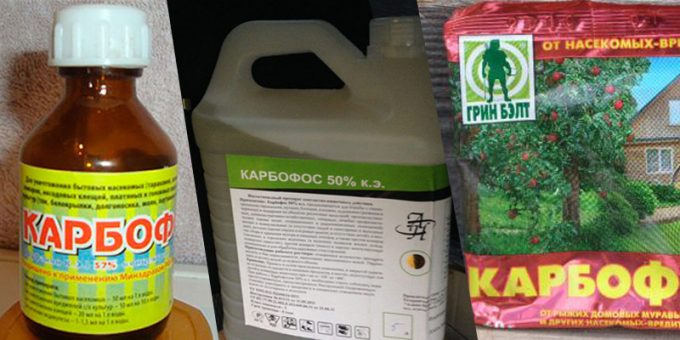
The beans can be attacked pea moth... It has the appearance of a brown butterfly. The danger is that the pest lays eggs not only on the leaves, but also inside the fruit. From which emerge yellow caterpillars eating beans. "Fentiuram" and "Phosphamide" will save from these insects. Spraying is carried out according to the instructions.
You can ward off the moth in advance by sowing legumes with mustard. Legumes are also susceptible to a fungal disease called anthracosis. It affects the aboveground part of the cultures. A sign of the appearance of the disease is brown-red spots on the surface of the leaves. If you do not take up treatment, the plant will shed its foliage.
Watering the beans
Regular watering is important during the flowering period. Further care must be taken to avoid constant waterlogging of the soil. This threatens the appearance of a "black leg" - rotting of the stem of the plant.
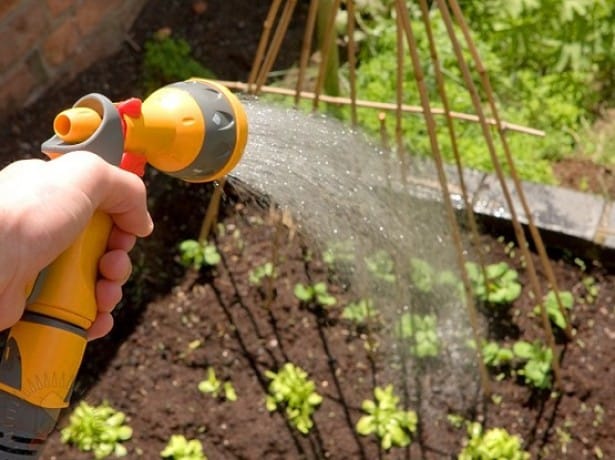
When and how to harvest the beans?
The ripening period of a crop differs depending on the region.The harvesting periods of legumes are different due to the purpose and further use of the fruit.
Based on this, several stages can be distinguished:
- For eating green pods. They should be juicy and tender. Such fruits are harvested during milk ripeness, which occurs 12-14 days after flowering. Harvesting begins at the bottom of the stems, where the beans ripen first. These pods are suitable for salads, side dishes.
- For further storage or for planting seeds. Such a crop is harvested from the garden when the pods begin to darken and crack right on the stem. Dried beans are used to make soups or side dishes.

The seeds retain their similarity for 5 or even 10 years. For greater safety, it is recommended to store them in a dry and dark place.
How to store beans for the winter?
When the entire crop is harvested, the remaining stem is cut off. The ground with the rhizome is dug up before wintering. The root and stem of the beans is a good compost for the soil, which will enrich it with nitrogen. Beans are stored in a variety of ways.
Drying
Thus, you can prepare ripe pods, fruits. Do not dry them in direct sunlight. The crop should be spread in the shade, in a well-ventilated area or outdoors, but brought into the house at night.
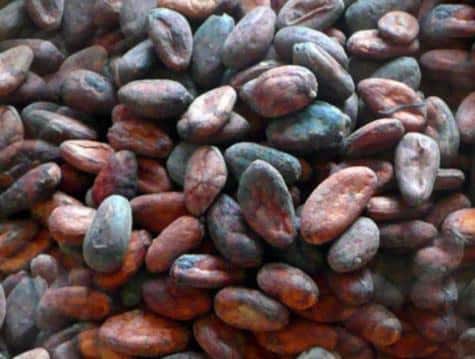
Freezing
Only green pods or fruits are frozen. They are washed, blanched, hermetically packed and sent to freezers. They can be stored there for 8-12 months.
Conservation
Green legumes and pods are also used. After blanching, they are placed in a sterile container. Then it is poured with hot brine, prepared to taste, and pasteurized for about 1.5 hours at + 80 ° C. Can be canned not separately, but in the form of a variety of salads, combining with any vegetables and herbs. There are many similar recipes that can be found in cookbooks or on the internet.
If you have a plot of land that is suitable for growing vegetables. Sowing beans is worth trying. You will benefit twice. Harvest this highly beneficial crop and at the same time enrich the soil on the site thanks to the ability of legumes to fertilize the soil.
